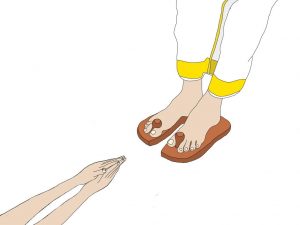Fall brings color to the world. Trees everywhere turn golden, brown, red and yellow, making even mundane surroundings suddenly rich with beauty. Fall is also a season of celebrations across the world—right from fall festivals, Oktoberfest and Halloween in the West, to Navaratri/Dussehra and Diwali in India and Hindu households—that , in turn, make mundane days suddenly rich with life, laughter and joy.
 The fall/autumn season or sharad ritu is a special time of the year in India. Hindu scriptures speak of six seasons—vasanta (spring), greeshma (summer), varsha (monsoon), sharad (autumn), hemant (pre-winter) and shishir (winter). Of these, the sharad ritu is the most beautiful, pure and auspicious, especially so because of its close relationship with Lord Krishna’s important leelas in Brindavan.
The fall/autumn season or sharad ritu is a special time of the year in India. Hindu scriptures speak of six seasons—vasanta (spring), greeshma (summer), varsha (monsoon), sharad (autumn), hemant (pre-winter) and shishir (winter). Of these, the sharad ritu is the most beautiful, pure and auspicious, especially so because of its close relationship with Lord Krishna’s important leelas in Brindavan.
In Srimad Bhagavatam, the sharad season is described wonderfully in a sloka by Sri Suka, providing a resplendent setting and background for the entry of the most beautiful Lord. In the beginning of the Venu Gitam in Canto 10 of the Purana, Sri Suka describes:
ittham sharad swaccha jalam padmAkara sugandhinA
nyavishad vAyunAvAtam sa gOgOpAla kOchyutaha
kusumita vanarAji sushmibhrunga dvijakula gushTa sarah sarIn mahIdram
madhupatir avagAhya chArayangAha saha pashupAla balahaschukUja vENum
He says, “sharad swaccha jalam” – the water is pure during sharad season. Summer is hot and humid; there is no reprieve. The rainy season, although there is abundance of water, is full of slush; the water is muddy and not pure. However, once autumn arrives, the mud has settled down, the downpours have stopped. The water is pure, fresh and fit to play host to the beautiful lotuses waiting to bloom. In the autumn, the monsoon clouds too have disappeared, making way for clear sunshine and hence lotuses bloom and spread their fragrance everywhere – “padmAkara sugandhinA”.
Flower buds, that had hitherto been soaked and ruined by incessant monsoon rains, can in the autumn bloom unrestrainedly – “kusumita vanarAji” – filling the trees with color. The aroma and nectar of these flowers in turn attract buzzing honey bees (“sushmi bhrunga”). With fragrance, color and cheer all around, can the cuckoos and peacocks help themselves but sing and dance to their hearts content – “dvija kula gushTa sarah sarin mahIdram”.
Finally, the autumn also gives happiness to the cows. In the rainy season, cows cannot graze as the grass, when pulled, comes up along with its muddy roots because of the wet soil. However, in the autumn, the cows graze happily and thus produce more milk, bringing prosperity all around.
Imagine how beautiful it would have been in Brindavan at this time of the year! It is against this stunning backdrop that Sri Suka describes the enchanting cowherd Lord as he plays his magical flute that pulls on the heart strings of everyone who hears it. This sharad season is the time when Lord Krishna played His most interesting leelas: Venu Gitam, Govardhana Uddharanam and Rasa Kreeda.
We may long to visit Brindavan, but Sri Muralidhara Swamiji sings in his kirtan, “Brindavaname un maname, leelaigal nadandidum dinam diname…”. Your heart is verily where Brindavan lies, and where the Lord will play His leelas every day!
We can truly enjoy the Lord’s play in our own hearts if we simply let the dried foliage of vices fall away, and allow the rain of grace to bring in freshness and saatvika bhava. Then our hearts will be pure and filled with blooming lotuses and flowers, buzzing bees and singing birds, providing the right setting for the Lord’s entry.
Narayanan Sathiamoorthy, Boston, MA
Illustration: Sripriya Sarathy, Charlotte, NC






